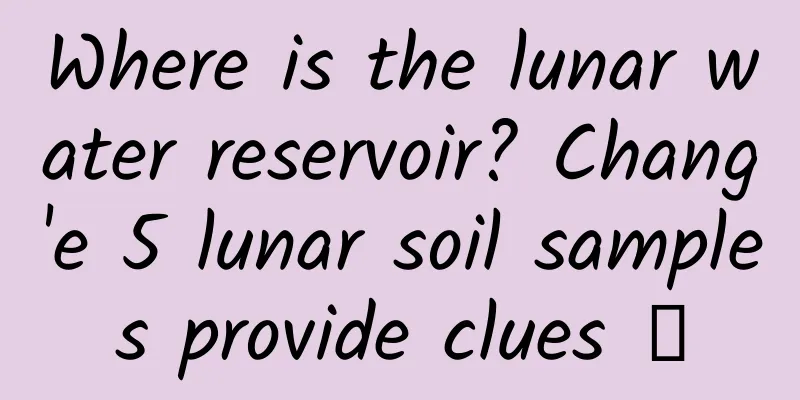Where is the lunar water reservoir? Chang'e 5 lunar soil samples provide clues →

|
Does the moon have a water reservoir? If so, where is it? The Chang'e-5 lunar samples brought a surprise to solve this mystery. On March 27, an article published in the international academic journal Nature Geoscience stated that Chinese and British scholars measured water in the impact glass beads in the Chang'e-5 lunar samples and found that the water content in the glass beads gradually decreased from the edge to the center. The research team speculated that this was because hydrogen ions in the solar wind were injected into the impact glass beads and diffused and preserved inside them. In the past 20 years of lunar exploration, humans have discovered a large amount of water on the lunar surface. Researchers believe that hydrogen ions in the solar wind combine with oxygen in lunar surface materials to form hydroxyl groups or water molecules and maintain the water cycle on the lunar surface. "There is also a view that there is an aquifer deep in the lunar soil. However, this aquifer has never been discovered," said Hui Hejiu, co-corresponding author of the paper and professor at Nanjing University. In space, meteorites and asteroids hit the moon, melting the soil and rocks on the lunar surface. These melts splash out, and the droplets formed cool down to form impact glass beads. There are a lot of impact glass beads in the Chang'e 5 lunar samples. Hui Hejiu introduced that in this study, scholars from the Institute of Geology and Geophysics of the Chinese Academy of Sciences, the University of the Chinese Academy of Sciences, Nanjing University, the University of Science and Technology of China and other research institutions, together with British scholars, conducted a detailed study of 32 impact glass beads with uniform texture in the lunar soil of Chang'e 5. The results showed that the average water content of the impact glass beads can be as high as 0.05%. "This is equivalent to 0.5 kilograms of water in 1 ton of impact glass beads, which is more than we imagined. The water in the glass beads here is not water in the usual sense, but hydrogen present in the glass beads, which can be converted into water that we can use through certain reactions." Hui Hejiu said. What is more interesting is that the water content in the impacting glass beads shows obvious diffusion ring characteristics, and the water content decreases from the outer edge of the glass beads to the core. The reason for this phenomenon was revealed in the subsequent research of the scientific research team. "The hydrogen isotope composition of the water-rich outer region in the impact glass beads is similar to the hydrogen isotope composition of the solar wind, so we speculate that the water in the outer region comes from the injection of hydrogen from the solar wind." Hui Hejiu explained. The researchers also found that the hydrogen content at the edge of some glass beads decreased. They speculated that this should be because the glass beads experienced a later impact or heating event, causing them to lose some water. "The new mechanism discovered in this study reveals that the impact glass beads in the lunar soil are a treasure trove of water that can maintain the water cycle on the lunar surface. Combining the analysis of the thickness of the lunar soil on a global scale, the team inferred that the water storage capacity of the lunar soil can reach up to 2.7×1014 kilograms." Hui Hejiu believes that in future human deep space exploration, impact glass beads may be used as a candidate water source to provide supplies, but the prerequisite is that the efficiency of collecting glass beads and extracting water must be high. |
<<: Rare! Bathing can cause illness. What is "bird" disease?
>>: The guys who delivered the express to you were all martial arts masters back then!
Recommend
The competition between BYD and CATL is escalating, and the head effect of the power battery industry is becoming increasingly obvious
On July 4, CATL announced the establishment of a ...
2020 full network marketing promotion methods!
Since the rise of online marketing, online market...
Ronglian Cloud Communications Zhang Jingyu: Restructured architecture IM5.0 will be faster, more economical and more stable
With the widespread coverage of 4G networks and w...
Why mosquitoes aren't going away? Here's some good news and some bad news
"Buzz, buzz, buzz..." One of the nightm...
Tik Tok short video marketing tips!
Douyin is a platform mainly based on short videos...
How can a corporate Douyin account become a hit? How to use corporate TikTok account
Recording a beautiful life is the slogan of Tik T...
How to place advertisements on Toutiao?
Since last year, a word has become particularly p...
Have you done 2 hours of outdoor activities every day?
In recent years, the incidence of myopia in my co...
How do technical founders choose non-technical partners?
[[121542]] There are many articles and blogs that...
If it doesn’t look like the Land Rover Aurora or the Landwind X7, will anyone still buy it?
Plagiarism and imitation are the inevitable paths...
SEM small search delivery guide: bidding small channels
In SEM, there are five main promotion channels: B...
25 Psychological Skills That Marketers Must Know
Why do marketers need to understand psychology? B...
Why do I often see small black spots in front of my eyes? Will it make me blind? These people should pay special attention to this
Expert of this article: Xu Qibin, associate chief...
How much does it cost to make a rain gear app in Suzhou?
Suzhou rain gear applet production price 1. Displ...
Will a nap while lying on your stomach cause gastroptosis? The truth is...
Rumor: "Taking a nap lying on your stomach w...









